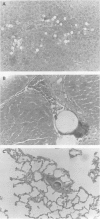Abstract
Available experimental models of portal hypertension are based either on cirrhosis or externally applied portal vein constricting devices. A new method is described of raising portal pressure, which uses intraportally injected microspheres to block intrahepatic portal radicles, which has the advantages of retaining normal liver architecture and providing a more clinically relevant intrahepatic obstruction to portal flow. Measured aliquots of microspheres (15, 25, 50, 90 microns) or equivalent volumes of saline were injected into a peripheral portal tributary (caecal vein) of 22 normal rats. The resultant changes in arterial, portal, and splenic pulp pressures were monitored. Sequential microsphere injections produced graduated rises in portal pressure up to a peak of 18.5-22.5 mm Hg (8.7-12.4 mm Hg increase from basal), which declined gradually to a steady state pressure of 13.3-15.1 mm Hg (4.0-5.0 mm Hg increase). There was no significant difference between pressure increases produced by microspheres of differing sizes. It is concluded that portal hypertension can be produced acutely by blocking portal radicles with microspheres. The maximum pressure achieved, however, is substantially less than that obtained by total portal vein occlusion (mean: 57.6 mm Hg). This suggests the existence of functional intrahepatic portal systemic shunts not previously described in the normal liver.
Full text
PDF



Images in this article
Selected References
These references are in PubMed. This may not be the complete list of references from this article.
- Bengmark S., Borjesson B., Olin T. Transposition of the spleen in rats with portal hypertension. Br J Surg. 1976 Apr;63(4):268–271. doi: 10.1002/bjs.1800630405. [DOI] [PubMed] [Google Scholar]
- Benoit J. N., Womack W. A., Korthuis R. J., Wilborn W. H., Granger D. N. Chronic portal hypertension: effects on gastrointestinal blood flow distribution. Am J Physiol. 1986 Apr;250(4 Pt 1):G535–G539. doi: 10.1152/ajpgi.1986.250.4.G535. [DOI] [PubMed] [Google Scholar]
- Chojkier M., Groszmann R. J. Measurement of portal-systemic shunting in the rat by using gamma-labeled microspheres. Am J Physiol. 1981 May;240(5):G371–G375. doi: 10.1152/ajpgi.1981.240.5.G371. [DOI] [PubMed] [Google Scholar]
- Groszmann R. J., Vorobioff J., Riley E. Splanchnic hemodynamics in portal-hypertensive rats: measurement with gamma-labeled microspheres. Am J Physiol. 1982 Feb;242(2):G156–G160. doi: 10.1152/ajpgi.1982.242.2.G156. [DOI] [PubMed] [Google Scholar]
- Halvorsen J. F., Myking A. O. Prehepatic portal hypertension in the rat. Immediate and long-term effects on portal vein and aortic pressure of a graded portal vein stenosis, followed by occlusion of the portal vein and spleno-renal collaterals. Eur Surg Res. 1979;11(2):89–98. doi: 10.1159/000128055. [DOI] [PubMed] [Google Scholar]
- Jaffe V., Mathie R. T. Dynamic pressure measurements in the evaluation of a pancreaticolienal portal diversion model in the rat. Eur Surg Res. 1990;22(5):263–269. doi: 10.1159/000129111. [DOI] [PubMed] [Google Scholar]
- Jaffe V., Sandin B., Wilkins R. A. Radiological definition of a new model of portal diversion in the rat. Br J Radiol. 1990 Aug;63(752):615–619. doi: 10.1259/0007-1285-63-752-615. [DOI] [PubMed] [Google Scholar]
- Komeichi H., Katsuta Y., Aramaki T., Okumura H. A new experimental animal model of portal hypertension. Intrahepatic portal obstruction by injecting DEAE-cross-linked dextran microspheres into the portal vein in the rabbit. Nihon Ika Daigaku Zasshi. 1991 Jun;58(3):273–284. doi: 10.1272/jnms1923.58.273. [DOI] [PubMed] [Google Scholar]
- Kretschmer G. J., Sutherland D. R., Matas A. J., Payne W. D., Najarian J. S. Autotransplantation of pancreatic fragments to the portal vein and spleen of totally pancreatectomized dogs: a comparative evaluation. Ann Surg. 1978 Jan;187(1):79–86. doi: 10.1097/00000658-197801000-00015. [DOI] [PMC free article] [PubMed] [Google Scholar]
- Lebrec D., Poynard T., Hillon P., Benhamou J. P. Propranolol for prevention of recurrent gastrointestinal bleeding in patients with cirrhosis: a controlled study. N Engl J Med. 1981 Dec 3;305(23):1371–1374. doi: 10.1056/NEJM198112033052302. [DOI] [PubMed] [Google Scholar]
- Lee S. S., Girod C., Braillon A., Hadengue A., Lebrec D. Hemodynamic characterization of chronic bile duct-ligated rats: effect of pentobarbital sodium. Am J Physiol. 1986 Aug;251(2 Pt 1):G176–G180. doi: 10.1152/ajpgi.1986.251.2.G176. [DOI] [PubMed] [Google Scholar]
- Navasa M., Chesta J., Bosch J., Rodés J. Reduction of portal pressure by isosorbide-5-mononitrate in patients with cirrhosis. Effects on splanchnic and systemic hemodynamics and liver function. Gastroenterology. 1989 Apr;96(4):1110–1118. doi: 10.1016/0016-5085(89)91630-2. [DOI] [PubMed] [Google Scholar]
- Reichen J. Liver function and pharmacological considerations in pathogenesis and treatment of portal hypertension. Hepatology. 1990 Jun;11(6):1066–1078. doi: 10.1002/hep.1840110625. [DOI] [PubMed] [Google Scholar]
- Sikuler E., Groszmann R. J. Interaction of flow and resistance in maintenance of portal hypertension in a rat model. Am J Physiol. 1986 Feb;250(2 Pt 1):G205–G212. doi: 10.1152/ajpgi.1986.250.2.G205. [DOI] [PubMed] [Google Scholar]



